|
|

|
|
Author
|
Topic: ISRO Mars Orbiter Mission (MOM, Mangalyaan)
|
Robert Pearlman
Editor Posts: 49188
From: Houston, TX
Registered: Nov 1999
|
 posted 11-04-2013 07:16 AM
posted 11-04-2013 07:16 AM
   
Indian Space Research Organization (ISRO) release Mars Orbiter MissionMars Orbiter Mission is India's first interplanetary mission to planet Mars with an orbiter craft designed to orbit Mars in an elliptical orbit. The mission is primarily technological mission considering the critical mission operations and stringent requirements on propulsion and other bus systems of spacecraft. 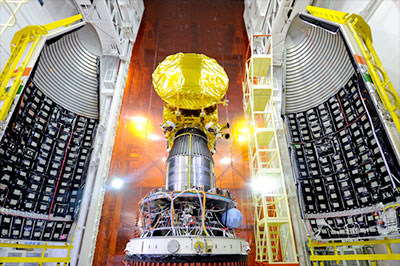 Mission Objectives One of the main objectives of the first Indian mission to Mars is to develop the technologies required for design, planning, management and operations of an interplanetary mission. Following are the major objectives of the mission: A. Technological Objectives: - Design and realization of a Mars orbiter with a capability to survive and perform Earth bound maneuvers, cruise phase of 300 days, Mars orbit insertion/capture, and on-orbit phase around Mars.
- Deep space communication, navigation, mission planning and management.
- Incorporate autonomous features to handle contingency situations.
B. Scientific Objectives: - Exploration of Mars surface features, morphology, mineralogy and Martian atmosphere by indigenous scientific instruments.
The launch of India's Mars Orbiter onboard a Polar Satellite Launch Vehicle (PSLV) rocket is set for Tuesday (Nov. 5) from Satish Dhawan Space Centre at 14:38 IST (3:08 a.m. CST; 0908 GMT). |
Robert Pearlman
Editor Posts: 49188
From: Houston, TX
Registered: Nov 1999
|
 posted 11-05-2013 03:49 AM
posted 11-05-2013 03:49 AM
   
collectSPACE India launches Mars probe on nation's 1st interplanetary missionIndia launched its first spacecraft to Mars Tuesday (Nov. 5), on a mission that — if successful — will include the country in the exclusive club of nations capable of sending probes to the Red Planet. The Mars Orbiter Mission lifted off at 3:08 a.m. CST (0908 GMT) on top a Polar Satellite Launch Vehicle (PSLV) from the Indian Space Research Organization's (ISRO) Satish Dhawan Space Center in Sriharikota. The 4.5 billion rupee ($73.5 million) mission is sending the "Mangalyaan" (Hindi for "Mars-craft") spacecraft on an 10-month voyage to Mars to observe the planet's surface and atmosphere. The orbiter carries five scientific instruments, but its primary purpose is to be a technology demonstrator for future interplanetary missions, ISRO officials said. 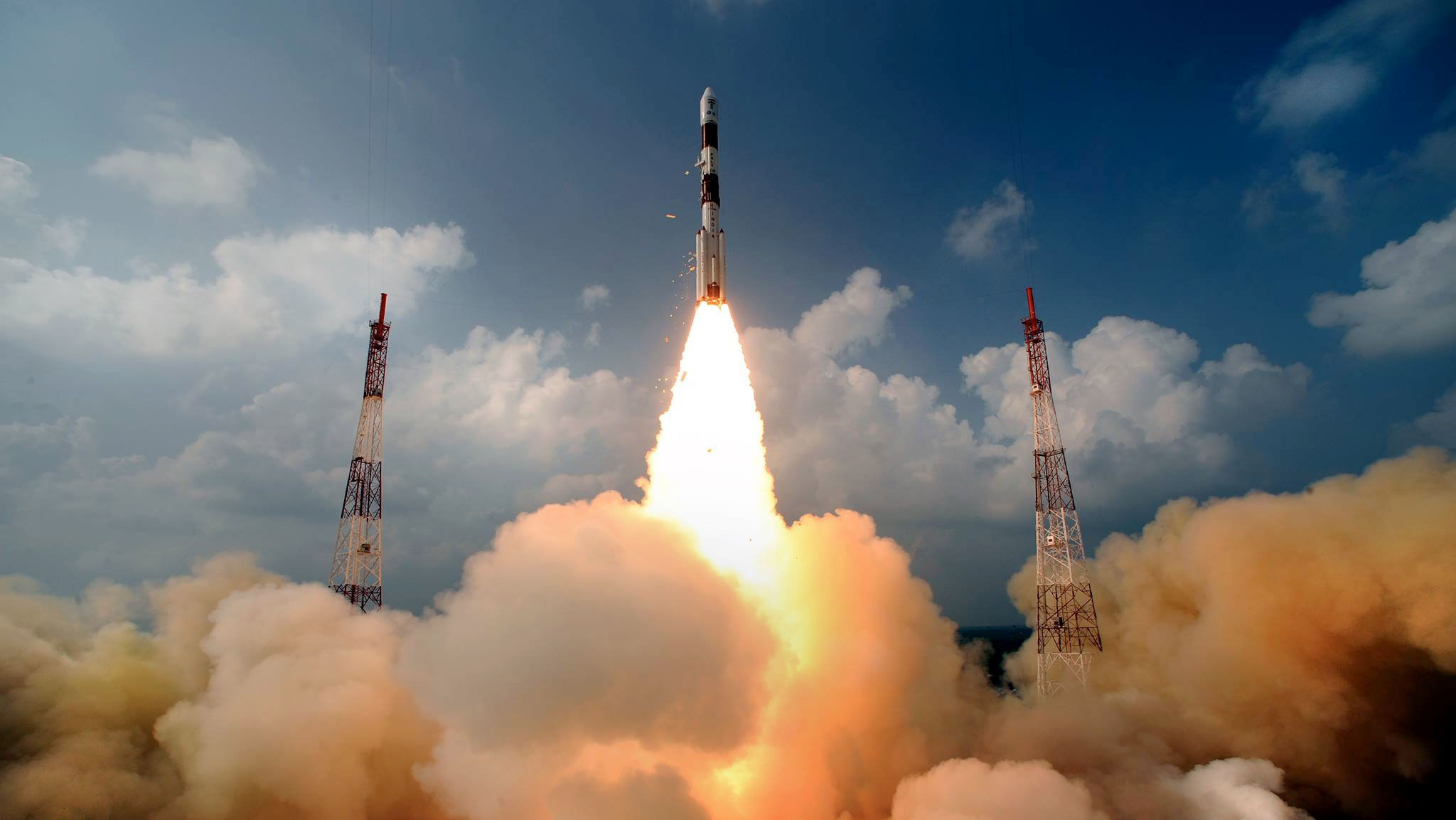 |
Robert Pearlman
Editor Posts: 49188
From: Houston, TX
Registered: Nov 1999
|
 posted 11-11-2013 05:05 AM
posted 11-11-2013 05:05 AM
   
Indian Space Research Organization (ISRO) release Supplementary Orbit Raising Maneuver Planned for Mars Orbiter SpacecraftIn the fourth orbit-raising operation conducted this morning (Nov 11, 2013), the apogee (farthest point to Earth) of Mars Orbiter Spacecraft was raised from 71,623 km to 78,276 km by imparting an incremental velocity of 35 meters/second (as against 130 meters/second originally planned to raise apogee to about 100,000 [1 lakh] km). The spacecraft is in normal health. A supplementary orbit-raising operation is planned tomorrow (November 12, 2013) at 0500 hrs IST to raise the apogee to nearly 1 lakh km. During the orbit-raising operations conducted since November 7, 2013, ISRO has been testing and exercising the autonomy functions progressively, that are essential for Trans-Mars Injection (TMI) and Mars Orbit Insertion (MOI). During the first three orbit-raising operations, the prime and redundant chains of gyros, accelerometers, 22 Newton attitude control thrusters, attitude and orbit control electronics as well as the associated logics for their fault detection isolation, and reconfiguration have been exercised successfully. The prime and redundant star sensors have been functioning satisfactorily. The primary coil of the solenoid flow control valve was used successfully for the first three orbit-raising operations. |
Robert Pearlman
Editor Posts: 49188
From: Houston, TX
Registered: Nov 1999
|
 posted 11-21-2013 07:45 AM
posted 11-21-2013 07:45 AM
   
Indian Space Research Organization (ISRO) release First image of Earth taken by Mars Color CameraThis image was taken on November 19, 2013 at around 01:50 PM IST from a height of almost 70,000 km above Earth and has a spatial resolution of 3.5 km. 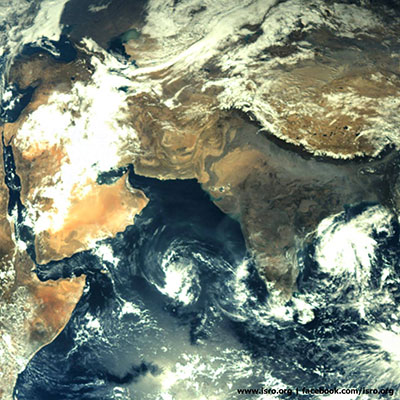 |
Robert Pearlman
Editor Posts: 49188
From: Houston, TX
Registered: Nov 1999
|
 posted 11-30-2013 03:34 PM
posted 11-30-2013 03:34 PM
   
Indian Space Research Organization (ISRO) release Mars Orbiter Spacecraft Successfully placed in Mars Transfer TrajectoryThe critical maneuver to place India's Mars Orbiter Mission spacecraft in the Mars transfer trajectory was successfully carried out in the early hours of Sunday (Dec. 1). During this maneuver, which began at 00:49 IST, the spacecraft's 440 Newton liquid engine was fired for about 22 minutes providing a velocity increment of 648 meters per second to the spacecraft. Following the completion of this maneuver, the Earth orbiting phase of the spacecraft ended. The spacecraft is now on a course to encounter Mars after a journey of about 10 months around the Sun. It may be recalled that the Mars Orbiter spacecraft was launched into an elliptical parking orbit with a perigee (nearest point to Earth) of 248 km and an apogee (farthest point to Earth) of 23,550 km by India's workhorse launch vehicle PSLV on Nov. 5, 2013. Following this, the apogee height of the spacecraft's orbit was successively raised through a series of maneuvers to nearly 193,000 km. Besides, health checks of the Mars Orbiter spacecraft as well as its payloads were performed. Since its launch, all systems on-board Mars Orbiter spacecraft are performing normally. The spacecraft is being continuously monitored from the Spacecraft Control Center at the ISRO Telemetry, Tracking and Command Network (ISTRAC) in Bangalore with support from the Indian Deep Space Network (IDSN) antennae at Byalalu. |
Robert Pearlman
Editor Posts: 49188
From: Houston, TX
Registered: Nov 1999
|
 posted 09-24-2014 01:46 AM
posted 09-24-2014 01:46 AM
   
collectSPACE India's Mars Orbiter Mission makes history entering orbit around Red PlanetFor the second time in as many days, a robotic spacecraft successfully entered orbit around Mars. This time however, the historic achievement was as much about where the probe came from as it was about it having arrived at the Red Planet. "India has become the first [country] to have made history by reaching Mars on its maiden attempt," Narendra Modi, India's prime minister, said, referencing the success of the Mars Orbiter Mission (MOM). "I congratulate the people of this country." On Tuesday evening (Sept. 23), ten months after it left the Earth, the Indian Space Research Organization's (ISRO) Mangalyaan (Hindi for "Mars Craft") fired its main engine to enter Mars' orbit. The critical maneuver led to the probe becoming only the 13th craft in history to begin circling the Red Planet. 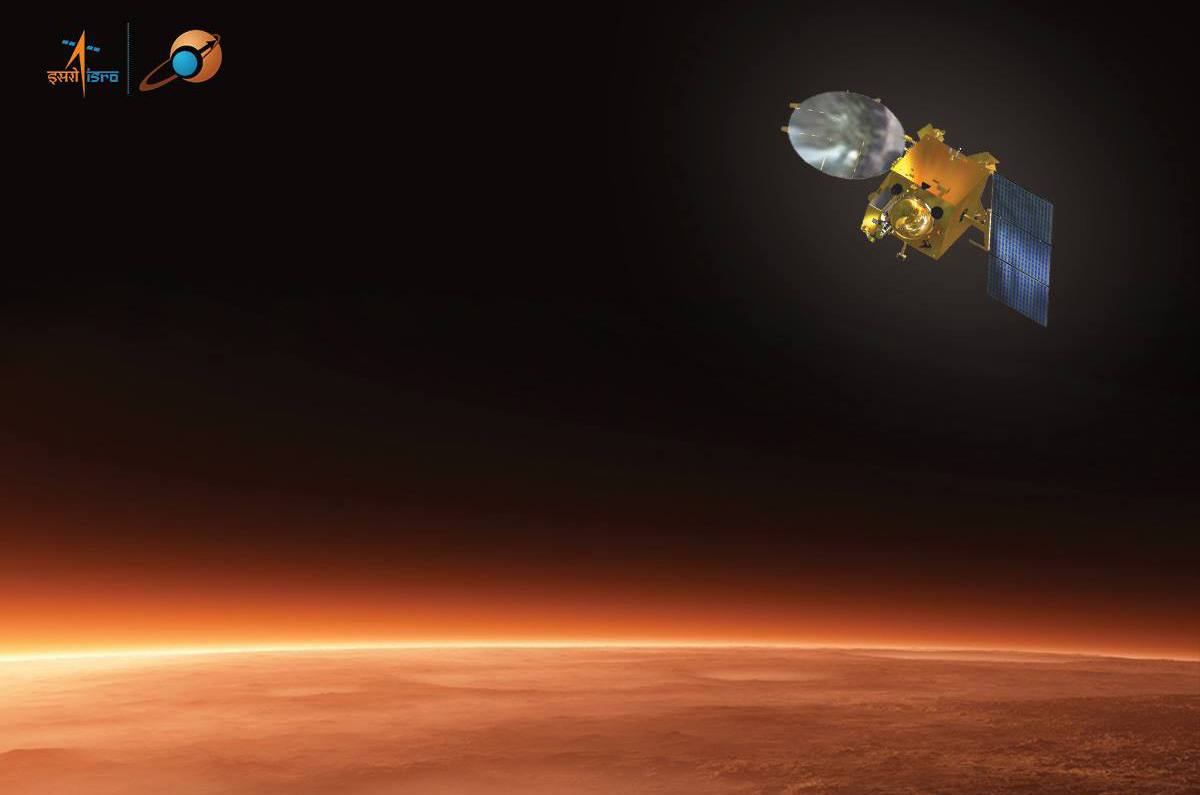 |
Robert Pearlman
Editor Posts: 49188
From: Houston, TX
Registered: Nov 1999
|
 posted 09-25-2014 07:54 AM
posted 09-25-2014 07:54 AM
   
Indian Space Research Organization (ISRO) photo release First LightISRO's Mars Orbiter Mission captures its first image of Mars. Taken from a height of 7300 km; with 376 m spatial resolution. 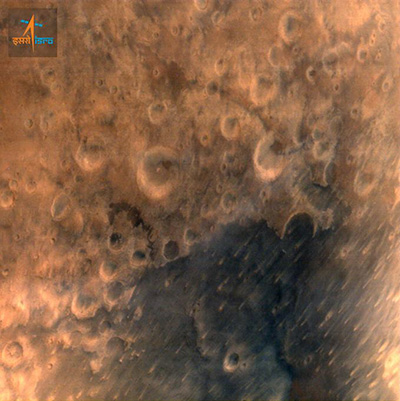 |
Robert Pearlman
Editor Posts: 49188
From: Houston, TX
Registered: Nov 1999
|
 posted 09-29-2014 10:49 AM
posted 09-29-2014 10:49 AM
   
Indian Space Research Organization (ISRO) photo release Regional dust storm activities over northern hemisphere of Mars [as] captured by Mars Color Camera on Mars Orbiter Mission.The image was taken from an altitude of 74500 km from the surface of Mars. 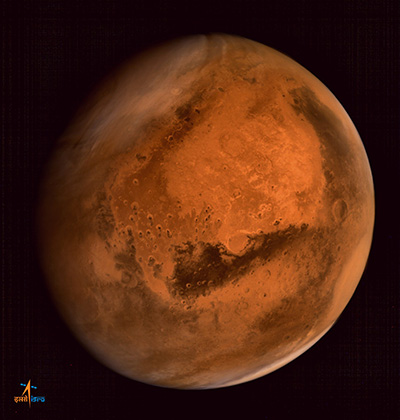 |
Robert Pearlman
Editor Posts: 49188
From: Houston, TX
Registered: Nov 1999
|
 posted 06-19-2017 08:10 AM
posted 06-19-2017 08:10 AM
   
Indian Space Research Organization (ISRO) release Mars Orbiter Mission Completes 1000 Days in OrbitMars Orbiter Mission (MOM), the maiden interplanetary mission of ISRO, launched on November 5, 2013 by PSLV-C25 got inserted into Martian orbit on September 24, 2014 in its first attempt. MOM completes 1000 Earth days in its orbit, today (June 19, 2017) well beyond its designed mission life of six months. 1000 Earth days corresponds to 973.24 Mars Sols (Martian Solar day) and MOM completed 388 orbits. MOM is credited with many laurels like cost-effectiveness, short period of realisation, economical mass-budget, miniaturisation of five heterogeneous science payloads etc. Satellite is in good health and continues to work as expected. Scientific analysis of the data received from the Mars Orbiter spacecraft is in progress. ISRO has also launched MOM Announcement of Opportunity (AO) programmes for researchers in the country to use MOM data for R&D. The success of Mars Orbiter Mission has motivated India's student and research community in a big way. Thirty-two proposals were supported under this AO. A Planetary data analysis workshop was also conducted to strengthen the MOM-AO scientist's research interest. First year data from MOM was released to public on September 24, 2016 through ISSDC website. There are 1381 registered users and 370 GB data has been downloaded. The Mars Colour Camera, one of the scientific payloads onboard MOM, has produced more than 715 images so far. Mars Atlas was prepared and made available on ISRO website. MOM went through a communication 'blackout" as a result of solar conjunction from June 2, 2015 to July 2, 2015. Telemetry data was received during most of the conjunction period except for 9 days from June 10-18, during superior conjunction. MOM was commanded with autonomy features starting from May 18, 2015, which enabled it to survive the communication "blackout" period without any ground commands or intervention. The spacecraft emerged out of "blackout" period with auto control of the spacecraft systems successfully. This experience had enabled the mission team to program a spacecraft about one month in advance for all operations. MOM spacecraft experienced the "whiteout" geometry during May 18 to May 30, 2016. A "whiteout" occurs when the Earth is between the Sun and Mars and too much solar radiation may make it impossible to communicate with the Earth. The maximum duration of "whiteout" is around 14 days. MOM spacecraft experienced the "whiteout" during May, 2016. However, MOM is built with full autonomy to take care of itself for long periods without any ground intervention. The entire planning and commanding for the "whiteout" was completed 10 days before the actual event. No commanding was carried out on the satellite in the "whiteout" period. Payload operations were suspended. Fault Detection, Isolation and Recovery were kept enabled, so as to take care of any contingency on the spacecraft. Master Recovery Sequencer was programmed, to acquire the attitude of the spacecraft and ensure communication with earth even in case of loss of attitude. The spacecraft came out of "whiteout" geometry successfully on May 30, 2016 and has been normalised for regular operations. An orbital manoeuvre was performed on MOM spacecraft to avoid the impending long eclipse duration for the satellite. The duration of the eclipse would have been as long as 8 hours. As the satellite battery is designed to handle eclipse duration of only about 1 Hour 40 minutes, a longer eclipse would have drained the battery beyond the safe limit. The manoeuvres performed on January 17, 2017 brought down the eclipse duration to zero during this long eclipse period. On the Evening of January 17, all the eight numbers of 22N thrusters were fired for a duration of 431 seconds, achieving a velocity difference of 97.5 m/s. This has resulted in a new orbit for the MOM spacecraft, which completely avoided eclipse up to September 2017. About 20 kg propellant was consumed for this manoeuvres leaving another 13 kg of propellant for its further mission life. Major results from the MOM scientific payloads are summarized here. |
Robert Pearlman
Editor Posts: 49188
From: Houston, TX
Registered: Nov 1999
|
 posted 10-03-2022 09:34 AM
posted 10-03-2022 09:34 AM
   
Indian Space Research Organization (ISRO) release Update on the Mars Orbiter Mission (MOM)On September, 27, 2022, ISRO had organized a one day National meeting to commemorate the Mars Orbiter Mission, on the event of completion of its eight years in the Martian orbit. The event witnessed active participation from several academic and research institutes, that included IISc, Bangalore, Bangalore University, NIT-Rourkela, Tripura University, Gorakhpur University, to name a few, as well as the centres and units of ISRO/DOS. The event was live-streamed to the ISRO website, and the ISRO social media platforms. Shri Shantanu Bhatwadekar, Scientific Secretary, ISRO, during his prelude address, mentioned that the Mars Orbiter Mission was launched on 5th Nov, 2013, and after completing 300 days of interplanetary journey, it was inserted to the Martian orbit on September, 24, 2014. Equipped with a suit of five scientific payloads onboard, during these eight years, the mission has gifted significant scientific understanding on the Martian surface features, morphology, as well as the Martian atmosphere and exosphere. Dr. K. Radhakrishnan, Member Space Commission, during his special address, mentioned about the unique lessons learnt from this mission; despite being realized in a remarkably short turn-around time, the MOM mission has added enormous values to the domains of science, technology, and management. It was an enormous feat to have reached the Martian orbit successfully in the maiden attempt, he mentioned. Shri. A.S. Kiran Kumar, Member Space Commission mentioned about the criticality of the payload operations in the Martian orbit, given the conflicting requirements of the payload operations, radio delay, and white-out and black-out conjunctions. During the inaugural address, Shri S. Somanath, Chairman, ISRO / Secretary, DOS, summarized the major scientific feats of the mission. He mentioned that the Mars Orbiter Mission has gifted an understanding of the composition of several gases in the Martian exosphere, quantified the altitude where the Martian atmosphere has a transition from the CO2 rich regime to atomic Oxygen-rich regime during the local evening. The mission is also credited with the discovery of 'suprathermal' Argon-40 atoms in the Martian exosphere, which gave some clue on one of the potential mechanisms for the escape of atmosphere from Mars. Chairman, ISRO further mentioned that the observation of the Martian dust storm from the MOM spacecraft gifted an understanding of the dynamics of the dust on the planet, as well as a potential mechanism of escape of the Martian atmosphere. The Atmospheric optical depth was estimated with the help of the MOM observations and the studies reported the presence of lee-wave clouds above the southern wall of Valles Marineris. The MOM spacecraft photographed, for the first time, the far side of Deimos, one of the natural satellites of Mars. The mission could capture the full disc image of Mars because of its elliptical orbit; it also generated an atlas of Mars with the help of the colour camera onboard the mission. The mission also captured the time-variation of the Martian polar ice caps; it also measured the Martian apparent albedo that indicated the reflecting power of the Martian surface. The mission also gave an opportunity to classify extra-terrestrial landslides using machine learning models. During the meet, it was also presented that there has been a high demand for the Mars Orbiter Mission data globally. So far, more than 7200 users have registered to download the MOM data from the portal of the Indian Space Science Data Centre (ISSDC), and about 27000 downloads of science data have been carried out so far. Among the registered users, about 400 are international users from 50 countries. The mission has also contributed to Human Resource Generation in the domain of planetary sciences; it has generated several Ph.D holders, while many of the research scholars are using the data from the mission to pursue their doctoral work. The deliberations during the national meet covered topics on the challenges faced by the Mars Orbiter Mission, lessons learnt from them, how to access the mission data from the portal of the Indian Space Science Data Centre (ISSDC), as well as a series of detailed presentations on the science outcomes by the principal investigator teams as well as the academia partners. A session was dedicated to a panel discussion on 'Future Exploration of the Inner Solar System: Scope and the Focus Areas' with the participation of Indian academia/institutes and ISRO/DOS. It was also discussed that despite being designed for a life-span of six months as a technology demonstrator, the Mars Orbiter Mission has lived for about eight years in the Martian orbit with a gamut of significant scientific results on Mars as well as on the Solar corona, before losing communication with the ground station, as a result of a long eclipse in April 2022. During the national meet, ISRO deliberated that the propellant must have been exhausted, and therefore, the desired attitude pointing could not be achieved for sustained power generation. It was declared that the spacecraft is non-recoverable, and attained its end-of-life. The mission will be ever-regarded as a remarkable technological and scientific feat in the history of planetary exploration. | |
Contact Us | The Source for Space History & Artifacts
Copyright 2022 collectSPACE.com All rights reserved.

Ultimate Bulletin Board 5.47a
|
|

|
 advertisement advertisement

|

















